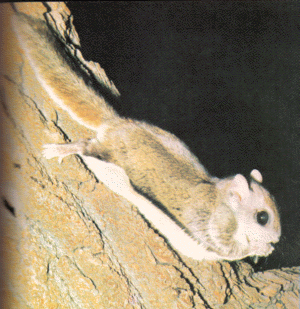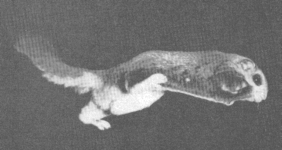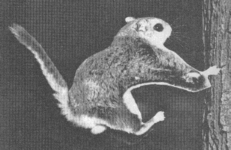 Northern Flying Squirrel Northern Flying SquirrelGlaucomys sabrinus
Description
Northern flying squirrels range
from about 7 to 10 inches in length, not
including the tail, which is generally about 80%
as long as the body. They have silky gray and
cinnamon brown fur, with white-tipped and
gray-based belly hairs. Both sexes are similar in
size and coloration. The most distinguishing
feature of the flying squirrel is a web of furred
skin along both sides of the body extending from
the foreleg to the hindleg and ending on the
tail.
Distribution and
Habitat
The northern flying squirrel
ranges from the treeline in Alaska and Canada
southward to northern California and Colorado,
and from central Michigan and Wisconsin into
northern North Carolina and Tennessee. It is most
commonly found in areas dominated by conifers,
but are also found in deciduous and mixed
forests.
Habits and Behaviors
Strictly nocturnal, northern
flying squirrels are active for about two hours
beginning an hour after sunset, and again for
about one-and-a-half to two hours before sunrise.
They rest by day in hollows in trees and will
also use roof spaces, outbuildings and bird
nesting boxes.
Female northern flying
squirrels are territorial, but males are not.
Groups of up eight adults and juveniles may share
a single nest, especially during the winter.
Diet
Like most squirrels, the
northern flying squirrel feeds on nuts, acorns,
fungi, and lichens, supplemented by fruits, buds,
sap, and the occasional insect and bird egg. Food
is often hoarded in order to ensure a steady
supply during the winter months.
Reproduction
Breeding takes place between
March and May, with one to six young born after a
gestation period of 37 to 42 days. Young are
weaned after about two months, and are able to
live on their own after about three months.
Sexual maturity is reached at about one year of
age.
Flight Abilities
One could say that flying
squirrels do not truly fly because they do not
have wings like birds or bats, and such a
statement would be somewhat true. However, to say
that a flying squirrel simply glides from one
tree to another would actually be quite far from
the truth. In fact, the only real difference
between birds/bats and flying squirrels is that
the former are capable of powered flight, whereas
the latter engage in controlled flight without
wing beats.
 Before becoming airborne a flying
squirrel leans its head first to one side then to
the other, getting a "fix" on the
distance and direction it must travel to its
desired landing spot. After determining where it
wishes to land, the squirrel leans forward,
pushes with its hind legs and spreads all four
legs at right angles to the body so the flying
membranes form a near-perfect square. In flight,
the squirrel uses its tail as a balance and a
rudder to help keep it on course. In
addition, by dropping the legs of one side, to
give added lift to the membrane on the other
side, the squirrel can bank or turn sharply. It
can also dive steeply and use the speed to rise
steeply at the end of the dive. Before becoming airborne a flying
squirrel leans its head first to one side then to
the other, getting a "fix" on the
distance and direction it must travel to its
desired landing spot. After determining where it
wishes to land, the squirrel leans forward,
pushes with its hind legs and spreads all four
legs at right angles to the body so the flying
membranes form a near-perfect square. In flight,
the squirrel uses its tail as a balance and a
rudder to help keep it on course. In
addition, by dropping the legs of one side, to
give added lift to the membrane on the other
side, the squirrel can bank or turn sharply. It
can also dive steeply and use the speed to rise
steeply at the end of the dive.
 On landing,
the squirrel immediately races around to the
other side of the tree, a precaution against
attack from a predator while still recovering
from the landing. On landing,
the squirrel immediately races around to the
other side of the tree, a precaution against
attack from a predator while still recovering
from the landing.
Although most glides are simple, from one tree
to another in a direct line, flying squirrels
have been seen to make right-angled turns,
lateral loops, spiral ascents and other
aerobatics. They have even been seen to change
their minds in mid-flight, turn completely around
and land again on the exact spot from which they
had just taken off.
Young flying squirrels make their first short
flights, under the close supervision of their
mothers, at about one month of age.
Scientific
Classification
Phylum Chordata
Subphylum Vertebrata
Class
Mammalia
Order
Rodentia
Suborder Sciurognathi
Family Sciuridae
Subfamily Pteromyinae
Genus and Species Glaucomys sabrinus

Animal Diversity Web http://animaldiversity.org/accounts/Glaucomys_sabrinus/
Questions or comments about
this page?
|



